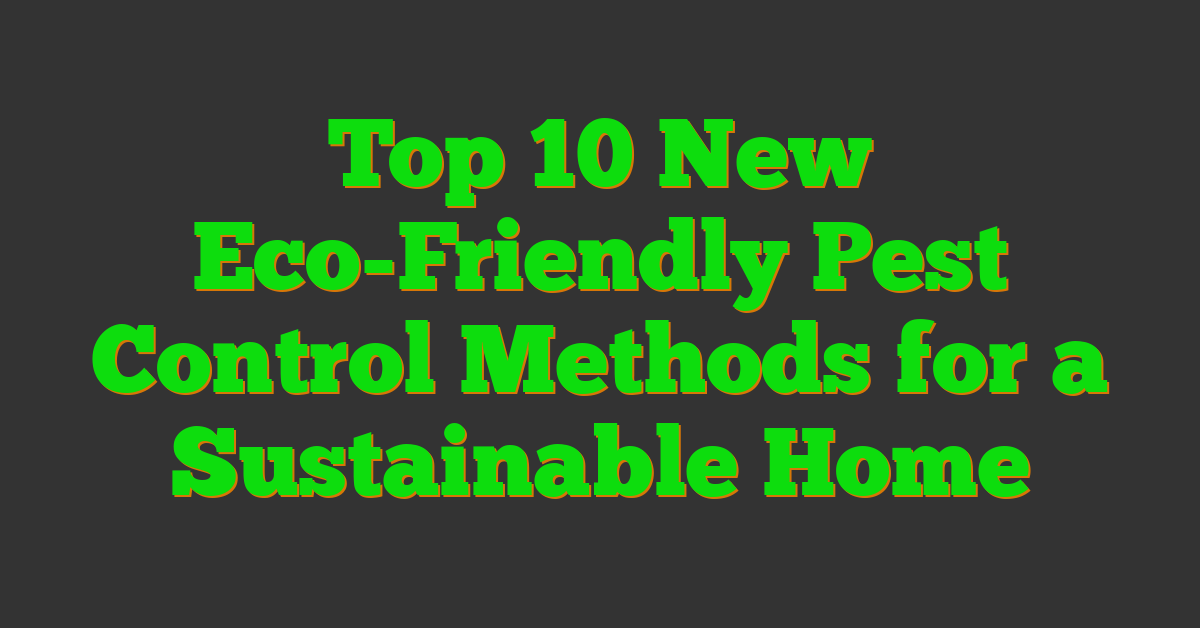Living in a pest-free home shouldn’t come at the expense of our environment. I’ve always been passionate about finding solutions that are both effective and eco-friendly. Recently, I dove into the latest pest control methods that prioritize sustainability without compromising on results.

From natural repellents to innovative technologies, there are so many options that help maintain a healthy home and a healthy planet. In this article, I’ll explore some of the best new eco-friendly pest control strategies that you can easily incorporate into your daily life.
Overview of New Eco-Friendly Pest Control Methods
I explore several innovative approaches to eco-friendly pest control that effectively protect your home while preserving the environment.
Biological Control
Introducing natural predators, such as ladybugs for aphid management, reduces pest populations without harmful chemicals.
Botanical Pesticides
Using plant-based substances like neem oil and pyrethrin targets pests while minimizing environmental impact.
Integrated Pest Management (IPM)
Combining cultural, biological, and mechanical methods creates a comprehensive strategy for sustainable pest control.
Smart Technologies
Implementing IoT-enabled traps and sensors allows real-time monitoring and targeted pest management, enhancing efficiency.
Essential Oil Repellents
Applying oils like peppermint and eucalyptus deters pests naturally, providing a safe alternative to synthetic repellents.
Genetic Pest Control
Employing gene drive technologies disrupts pest breeding cycles, offering long-term solutions with minimal ecological disruption.
Vacuum Pest Control
Utilizing specialized vacuum devices removes pests physically, eliminating the need for chemical interventions.
Diatomaceous Earth
Sprinkling diatomaceous earth damages pest exoskeletons, effectively controlling infestations without toxins.
Ultrasonic Repellents
Deploying ultrasonic devices creates environments unfavorable to pests, ensuring a chemical-free deterrent method.
Feromone Traps
Setting pheromone-based traps attracts and captures specific pests, reducing their population through targeted means.
Comparison of Traditional and Eco-Friendly Methods
| Method | Environmental Impact | Effectiveness |
|---|---|---|
| Chemical Pesticides | High | High |
| Biological Control | Low | Moderate to High |
| Botanical Pesticides | Low | Variable |
| Integrated Pest Management | Low to Moderate | High |
| Smart Technologies | Low | High |
Latest Innovations
I delve into the latest eco-friendly pest control innovations that offer effective solutions while protecting our environment.
Biological Control Techniques
Biological control leverages natural predators to manage pest populations. Introducing ladybugs can reduce aphid numbers by up to 90%. Parasitic wasps target caterpillars, minimizing the need for chemical interventions. These methods maintain ecological balance and prevent pest resurgence.
Natural Repellents and Deterrents
Natural repellents use plant-based substances to keep pests away. Essential oils like peppermint and eucalyptus effectively deter rodents and insects. Physical barriers, such as diatomaceous earth, provide non-toxic pest prevention. These strategies offer safe alternatives to conventional pesticides, ensuring a healthy living environment.
Benefits of Eco-Friendly Pest Control
Health Improvement
Using eco-friendly pest control reduces exposure to harmful chemicals, ensuring a healthier living environment for my family and pets. Natural methods like essential oil repellents maintain air quality without the risks associated with synthetic pesticides.
Environmental Sustainability
Eco-friendly approaches support sustainable practices by preserving local ecosystems. Implementing biological controls, such as introducing ladybugs, helps maintain the balance between pests and their natural predators, contributing to long-term environmental health.
Cost Efficiency
Natural pest control methods often require less frequent application, leading to lower maintenance costs. Investing in physical barriers like diatomaceous earth can provide long-lasting protection, reducing the need for ongoing expenses associated with chemical treatments.
« DIY vs. Professional Landscaping Costs: Which Option Saves You More? When to Hire a Landscape Architect: Signs, Benefits, and Expert Tips for Your Outdoor Projects »
Safety Assurance
Non-toxic pest management eliminates the dangers of chemical exposure. Methods like ultrasonic repellents and vacuum pest control ensure safety for all household members without compromising effectiveness in managing pest populations.
Biodiversity Enhancement
Promoting diverse biological controls encourages a variety of beneficial species. Genetic pest control techniques, such as gene drive technologies, not only target specific pests but also support overall biodiversity by minimizing collateral impacts on non-target organisms.
Regulatory Compliance
Adopting eco-friendly pest control aligns with increasing regulations aimed at reducing chemical pesticide use. Implementing Integrated Pest Management (IPM) strategies ensures compliance with environmental standards, avoiding potential legal issues and fostering responsible pest management.
Resource Conservation
Eco-friendly methods optimize resource use by leveraging natural processes. Smart technologies, like IoT-enabled traps, enhance efficiency in monitoring pest activity, ensuring targeted interventions that conserve both time and materials.
Implementation Strategies
To effectively adopt eco-friendly pest control methods, consider the following strategies:
Assess Your Pest Situation
- Identify Pests: Determine the specific pests affecting your home or garden. Accurate identification ensures the right control methods are applied.
- Evaluate Infestation Level: Assess the severity of the infestation to choose appropriate interventions.
Choose Suitable Eco-Friendly Methods
- Biological Control: Introduce natural predators like ladybugs for aphids or parasitic wasps for caterpillars.
- Natural Repellents: Apply plant-based oils such as peppermint or eucalyptus around entry points to deter insects and rodents.
- Physical Barriers: Use diatomaceous earth in cracks and crevices to prevent pest entry without toxins.
Integrate Multiple Approaches
- Combine Methods: Utilize a combination of biological controls, repellents, and physical barriers for comprehensive pest management.
- Implement Integrated Pest Management (IPM): Monitor pest populations and apply eco-friendly methods as needed to maintain balance.
Utilize Smart Technologies
- IoT-Enabled Traps: Deploy smart traps that provide real-time data on pest activity, enabling timely interventions.
- Automated Monitoring Systems: Use sensors and apps to track pest movements and effectiveness of control measures.
Maintain Regular Monitoring and Maintenance
- Routine Inspections: Regularly check for signs of pests to address issues promptly.
- Adjust Strategies: Modify your pest control methods based on monitoring results to ensure ongoing effectiveness.
Educate and Involve Household Members
- Awareness Training: Inform everyone in the household about eco-friendly practices and their roles in pest management.
- Consistent Practices: Encourage consistent application of prevention techniques to minimize pest opportunities.
Leverage Professional Assistance
- Consult Experts: Seek advice from pest control professionals specializing in eco-friendly solutions for tailored strategies.
- Regular Services: Schedule periodic professional assessments to maintain a pest-free environment sustainably.
Document and Evaluate Results
- Track Interventions: Keep records of the methods used and their outcomes to identify the most effective strategies.
- Continuous Improvement: Use documented results to refine and enhance your pest control approach over time.
By implementing these strategies, you can maintain an effective and sustainable pest management system that aligns with eco-friendly principles.
Challenges and Solutions
Implementing eco-friendly pest control methods presents several challenges, but with the right strategies, these obstacles become manageable. One common challenge is ensuring effectiveness compared to traditional chemical pesticides. To address this, I combine multiple eco-friendly approaches, such as integrating biological controls with natural repellents, enhancing overall pest management efficiency.
Another hurdle is the initial investment in setting up certain eco-friendly systems, like smart technologies for monitoring pests. However, the long-term savings on maintenance costs offset the upfront expenses. Additionally, I prioritize methods that require minimal ongoing investment, ensuring sustainability without breaking the bank.
Lack of awareness and knowledge about eco-friendly options can impede adoption. To overcome this, I continuously educate myself through reputable sources and professional consultations. Sharing this knowledge with household members also fosters a collective effort in maintaining a pest-free environment.
Seasonal variations and specific pest behaviors pose challenges in maintaining consistent pest control. I tackle this by scheduling regular inspections and adjusting methods as needed, ensuring that the chosen strategies remain effective throughout the year.
Lastly, integrating eco-friendly methods with existing pest control systems can be complex. I simplify this process by gradually introducing new techniques and monitoring their impact, allowing for seamless integration and optimal results.
| Challenge | Solution |
|---|---|
| Ensuring effectiveness | Combine biological controls with natural repellents |
| Initial setup costs | Invest in long-term savings through sustainable methods |
| Lack of awareness | Educate myself and household members |
| Seasonal pest variations | Schedule regular inspections and adjust methods accordingly |
| Integration with existing systems | Gradually introduce new techniques and monitor their impact |
By addressing these challenges with practical solutions, I successfully maintain an eco-friendly, pest-free home.
Conclusion
Embracing eco-friendly pest control has truly transformed the way I maintain my home. It’s rewarding to know that I’m protecting my space without harming the environment. Implementing these natural methods not only keeps pests at bay but also promotes a healthier living environment for my family and pets.
Switching to sustainable practices felt like a big step, but seeing the positive results makes it all worthwhile. I encourage everyone to explore these innovative solutions and find what works best for their homes. Together we can create pest-free spaces that are kind to our planet and future generations.
















